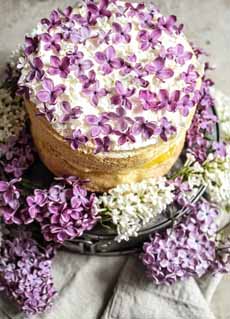TIP OF THE DAY: Garnishing With Lilacs

|
We received the top photo from Tay Tea, a lovely tea salon in Delhi, New York, some three hours northwest of New York City. The proprietor spent years as a blender of premium teas, and departed from owning tea salons in New York City to the country. Fortunately for her fans, she sells her teas online. The blends are beautiful to look at, and you can’t make a wrong choice. Back to the lilacs: Lilac blossoms are edible, though they smell better than they taste, so are best used in small amounts as a garnish (only use those that have not been sprayed with pesticides). They typically blossom in April and May. According to an article on Care2.com, you can “drink in the beauty and aroma” by making a cold-water infusion. The common lilac (Syringa vulgaris), one of 12 species of lilac, is a member of the Oleaceae family, commonly called the olive family. The family comprises flowering aromatic woody plants that includes, among others, ash, forsythia, jasmine and privet. Lilac is native to Eurasia. And it has a legend. |
|
|
In Greek mythology, a beautiful nymph named Syringa had caught the eye of Pan, the god of the forests and fields. He chased her through the forest; but she eluded him by turning herself into a lilac bush. Pan found himself holding hollow reeds instead of Syringa. (Note that in real life, lilac twigs are not hollow. They can, however, be easily drilled out.) Pan’s sighs, combined with the wind and the reeds, made harmonious sounds. Hermes, the fleet-footed messenger and god of boundaries and transitions, suggested that seven reeds of different lengths, bound together, could make what we now call pan pipes, an early flute. The flute was called Syrinx in honor of the nymph. Did Syringa spend the rest of her life as a lilac bush, to avoid Pan? The record is silent; but we thank her for inspiring the flute and other hollow tubes, such as sryinges for medicine and mechanical uses. |
||
